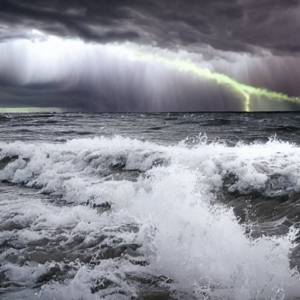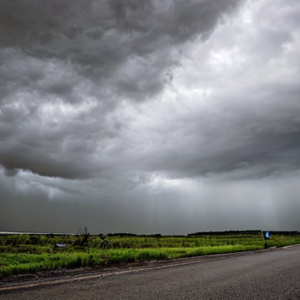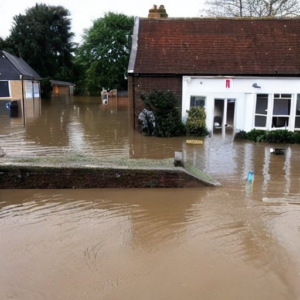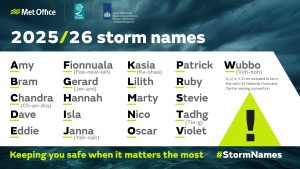This blog has been written by The Flood Hub People.
On the 1st September 2025, the Met Office, in collaboration with Met Éireann (the meteorological service in Ireland) and the KNMI (the Dutch national weather service), released the storm names for the 2025/26 season! Before we look at this year’s list of names, let’s take a closer look at the practice of naming storms as well as some of the more notable storms and their impacts from recent years.
The tradition of naming storms began in 1953 in the United States when the National Hurricane Centre (now the World Meteorological Organisation) began assigning female names to storms and hurricanes, with male names introduced from 1978 onwards. However, it wasn’t until 2014 that the Met Office in the UK decided to start giving storms male and female names in a similar tradition.
The Met Office, Met Éireann, and the KNMI select each year’s list of names from suggestions submitted by the public. The names are selected based on popularity and how well they represent the different cultures, nations and diversity across Britain and Ireland. Storm names are assigned in alphabetical order, however, to remain in line with the US National Hurricane naming conventions, storms are never assigned names beginning with the letters Q, U, X, Y and Z.

Only storms that are suspected to cause considerable damage or trigger an amber or red warning (medium or high impacts) are given a name. This is because naming storms helps to make them more personable and relatable to the public, which helps to raise awareness of the severe weather that a storm can bring, how dangerous they can be and the damaging effects they can have.
Storms can bring a range of disruptive and sometimes life-threatening weather events, including heavy rain and flooding, strong winds, storm surges and freezing rain. Therefore, it is important to be prepared and stay as safe and resilient as possible against the potential impacts.
Storms can bring some of the most severe and extreme weather events during the winter months, including lower temperatures, gale-force winds, and heavy precipitation, which can result in flooding. Storms occur at mid-latitudes where cold polar air meets warmer tropical air, and the point at which the two temperature differentials meet is known as the jet stream. Rising air from the Atlantic is replaced by the strong winds of the jet stream much quicker than the air at lower levels, and this reduction in pressure produces the strong winds of winter storms. Storms tend to form in the winter months when the temperature between the air masses is at its greatest.

Before we take a look at the chosen names for the 2025/26 storm season, let’s take a quick look at some of the more notable storms which have impacted the North of England quite significantly over recent years…
On the 5th and 6th December 2015, Storm Desmond brought strong winds of up to 81 mph and heavy rainfall, with 341.4mm of rain falling across Cumbria over 24hours on the 5th December. Many people across Cumbria and Lancashire were severely affected, with 5,200 homes flooded and 61,000 homes in Lancaster left without power when an electrical substation was flooded. Major roads were flooded across the north of England and Scotland, together with disruption to rail services, including a landslide which closed part of the West Coast mainline between Preston and Carlisle. Many homes and businesses were destroyed across the north of England and twelve months on, 1 in 5 homeowners were yet to return home.
Storm Eva brought prolonged and intense rainfall to already saturated catchments across Northwest England, due to earlier months of rainfall. River levels reached record highs, with the Irwell catchment recording 128mm of rainfall in 36 hours across Christmas Day and Boxing Day. This resulted in 2,250 homes and 500 businesses across eight local authority areas being flooded, with tens of thousands of people experiencing disruption from power cuts and road closures. In Lancashire, the river Calder burst its banks flooding communities in Whalley and Billington, resulting in many families needing to evacuate their homes.

Image: From video by J Whipps / Whalley flood recovery, Lancashire
Storm Ciara swept across the UK bringing high winds and heavy rainfall with a maximum wind speed of 97mph recorded at the Isle of Wight. Large amounts of rainfall affected much of Northwest England and North Wales, with Honister Pass gauge station in Cumbria recording 177mm of rain in the 24hr period leading up to 4pm on Sunday 9th February. A total of around 539,000 properties experienced power cuts across the UK and the Environment Agency issued 251 Flood Warnings, with many homes flooded and evacuated across the Northwest.
Less than a week after Storm Ciara, Storm Dennis brought additional widespread rain with between 150mm and 250mm falling across northern England, further exacerbating impacts on communities with a second wave of flooding. Properties were flooded in Tenbury Wells, Worcestershire as well as in Lowdham, Nottinghamshire and Pontypridd in Wales. Rail disruptions were also widespread.
Storm Christoph brought the wettest 3-day period of rainfall on record for Northwest England and North Wales, with over 100mm of rain falling across upland areas. Parts of Cheshire, Greater Manchester and Lancashire received a whole months’ worth of rain. Homes were flooded in Cheshire, with most of Northwich town centre under water, and further homes were evacuated in Chester, Warrington, Didsbury and Northenden in Manchester. As Storm Christoph moved eastwards, the northeast region experienced snowfall and blizzards, with emergency response and evacuation efforts hindered by the Coronavirus pandemic.

The 2024/25 storm season did in fact see 6 named storm events in total. Since the naming of storms in the UK started with the 2015/16 storm season, we’ve averaged around 7 storms per storm season.
You can see a breakdown of the number of storms from previous years in the table below.
| Year | No. of Storms | Name of last storm |
| 2015/16 | 11 | Katie |
| 2016/17 | 5 | Ewan |
| 2017/18 | 8 | Hector |
| 2018/19 | 8 | Hannah |
| 2019/20 | 6 | Francis |
| 2020/21 | 5 | Evert |
| 2021/22 | 6 | Franklin |
| 2022/23 | 2 | Betty |
| 2023/24 | 12 | Lilian |
| 2024/25 | 6 | Floris |
Storm Ashley was a powerful Atlantic storm which brought wet and windy weather to the UK, with Scotland seeing the highest gust speed of 121mph at Cairngorm Summit. Ferry services were cancelled in Scotland and Northern Ireland, with flights also cancelled at Belfast City Airport due to strong winds. Over 200 homes in North East Scotland experienced a loss of power, with rail services either being cancelled on placed on speed restrictions with waves battering coastlines. Further South, The Great South Run was cancelled due to safety concerns.
The weekend of Saturday 23rd to Sunday 24th was exceptionally wet across South Wales and south-west England bringing over 150mm of rainfall in the wettest upland areas. Accompanied by strong winds, Storm Conall brought a further 30 to 50mm of rain falling on already very wet ground along the South Coast from south Devon to Surrey and Kent.
Storm Bert brought strong winds, snow and heavy rain across the UK, unfortunately resulting in several deaths. The heavy rain brought flooding to all regions of the UK, with Environment Agency reporting around 680 properties were flooded in England, and the Welsh government reporting 433 properties flooded, most of which were in South Wales. Flooding occurred Wiltshire when the River Avon burst its banks in Bradford-upon-Avon, and Wiltshire when a wall collapsed under pressure from a local brook. A major incident was declared in Northamptonshire when a holiday park was inundated from the River Nene, and Tenbury Wells in Worcester also flooded when a wall collapsed under pressure, and over 50 children needed to be rescued from a school bus stuck in a flooded ditch near Evesham. Overall, 350,000 homes in England lost power during the storm and 300 flights were cancelled.
Arriving 2 weeks after Storms Bert and Conall, Storm Darragh brought high winds and heavy rains to western part of the UK, with the MET Office issuing a Red Warning for wind covering the coastline of West Wales and the Bristol Channel. Storm Darrah brought heavy rain which saw a further 50mm – 100mm of rainfall across upland areas in Wales, leading to concerns of further flooding. A major incident was declared by Dyfed-Powys Police with parts of Wales seeing fallen trees and damaged buildings. Across the UK, flights were cancelled at many airports and rail services were closed in Scotland and Wales, with disruption to rail lines in England and the closure of the M48 Severn Bridge. A number of deaths were reported together with 2.3million customers left without power. Falling powerlines and trees left 22 people stranded in a forest when their exit route was blocked, and a downed powerline on farmland in Cornwall resulted in the deaths of nine cows.
On 31st December 2024 to 1st January 2025 significant inclement weather brought wind and rain to parts of the UK. The MET Office issued Sever Weather Warnings, and although this weather event was not a named storm, it brought with it many of the impacts of a storm none-the-less. The Environment Agency issued 137 Flood Warnings across England, Scotland and Wales with the North West of England badly affected by flooding.
A major incident was declared by Greater Manchester Police, with Greater Manchester Fire and Rescue attending over 100 incidents and evacuating close to 1,000 people due to flooding across areas including Stockport, Didsbury and parts of Wigan. Cheshire and Merseyside were also affected by flooding, with a total of 541 properties flooded internally, and the collapse of a section of embankment along the Bridgewater Canal occurring near Little Bollington in Cheshire. This event demonstrates that sever impacts from weather events are not just associated with named storms.
Storm Éowyn proved to be the UK’s most powerful windstorm for over a decade, with the MET Office issuing a red warning for wind with a wider amber warning area covering the northern half of the UK. Scotland and Northern Ireland saw the highest wind speeds with gusts reaching 100mph at Drumalbin, Lanarkshire, and a weather station on Tiree in the Inner Hebrides recorded the UK’s lowest pressure reading since storm names were introduced in 2015. The MET Office issued a red warning for including all of Northern Ireland and central Scotland leading to school closures and people being advised to stay home. Storm Éowyn caused significant disruption with major road closures and rail services suspended along the East and West coast mainlines in Scotland. Ferry services were also cancelled and over 1000 flights were also reported to cancelled along with shops and supermarket closures. Strong winds and trees brought down powerlines resulting in over 1million homes being left without power, with several thousand remaining without power for several days. Many properties were damaged, and a leisure centre in Helesburgh had its roof torn off by strong winds. A small number of fatalities were also reported because of the Storm.
Since observational records began, Storm Floris was one of the more sever wind storms to have affected Scotland in the summer months with wind speeds recorded at in excess of 80mph. Over 70,000 properties in the Highlands, Aberdeenshire and Moray were reported to have lost power, with high winds also causing disruption to rail, road and air transport. Fallen trees blocked routes and most of Scotland’s bridges were closed to certain vehicles with some ferry services also cancelled. In addition, dozens of flights were cancelled, and rail disruptions saw the East Coast mainline closed north of Newcastle, and West Coast Mainline passengers advised not to travel north of Preston.
The MET Office has just released this years’ Storm names, how far down the list do you think we will get this year? Take a look at the list below to see if your name is on the list!
| Storm name | Date named | Date of impact on UK and/or Ireland and/or Netherlands |
| Amy | ||
| Bram | ||
| Chandra (Ch-an-dra) | ||
| Dave | ||
| Eddie | ||
| Fionnuala (Fee-new-lah) |
||
| Gerard (Jer-ard) | ||
| Hannah | ||
| Isla | ||
| Janna (Yah-nah) | ||
| Kasia (Ka-shaa) | ||
| Lillith | ||
| Marty | ||
| Nico | ||
| Oscar | ||
| Patrick | ||
| Ruby | ||
| Stevie | ||
| Tadhg (Tie-g) | ||
| Violet | ||
| Wubbo (Vuh-boh) |

Image: Met Office
You can submit storm name suggestions for the 2026/27 season by making a submission through the MET Office online form here: https://www.metoffice.gov.uk/forms/name-our-storms-call-for-names, or via email at: [email protected].
Source: MET Office, BBC